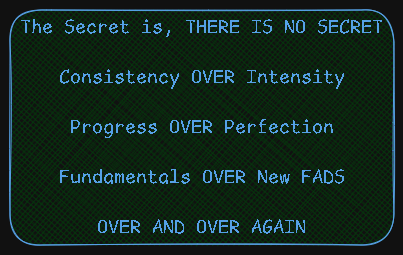The Power of Small Steps: How Incremental Learning Fuels Technical Innovation
Memory Matters #14


Technical excellence emerges from methodical progression, not dramatic leaps. Leading organizations demonstrate this principle clearly - 75% of top performers achieve breakthroughs through systematic, incremental improvements rather than radical changes.
Innovation in technology often evokes images of groundbreaking leaps, flashy product launches, and sweeping industry transformations. Yet recent announcements from NVIDIA—such as the unveiling of their advanced Blackwell Ultra AI chips at GTC 2025 and the establishment of a new quantum computing research center in collaboration with Harvard and MIT—highlight a powerful truth: some of the most significant advancements in the tech industry are driven by incremental, consistent improvements rather than singular, disruptive breakthroughs. NVIDIA’s approach, characterized by continuously refining chip architectures, progressively enhancing computational efficiencies, and systematically integrating insights from research and user feedback, underscores the profound impact of iterative learning.
Incremental learning—steadily building upon small improvements—drives significant technological advancements, as evident in modern AI architectures. Data supports this: organizations using structured incremental methods achieve efficiency gains of 10-30%. Clearly, incremental steps offer the most reliable path to transformative technical success.
The Science Behind Incremental Learning
Neural efficiency fundamentally depends on processing information in discrete, manageable units. This biological principle underpins successful technical learning and explains why methodical progression yields superior results.
How our brains process small chunks of information
Human cognitive architecture excels at processing bounded information segments. Cognitive psychology defines "chunking" as the mental organization of information into meaningful units, circumventing working memory limitations. Scientific measurements reveal our short-term memory capacity typically encompasses four distinct information chunks, establishing the biological basis for structured learning approaches.
Technical professionals harness chunking to master complex systems through component-level understanding. Each chunk forms a cohesive memory unit of related elements, enabling efficient recall and creating robust foundations for advanced concept integration.
The compound effect of daily technical practice
Systematic daily actions generate skill development momentum. This compound effect mirrors mathematical growth principles, where consistent small inputs yield exponential returns over time.
Technical mastery emerges through daily micro-improvements that appear minimal in isolation. Quantitative analysis demonstrates that 1% daily improvement compounds to 67% advancement over one year. This mathematical reality explains why steady progression outperforms sporadic intensive efforts. This is why simply showing up to run, speak in public, or brainstorm is a great portion of the battle.
Engineers realize three core benefits:
Knowledge synthesis accelerates exponentially, enabling innovative connections
Capabilities develop along exponential rather than linear trajectories
Complex challenges become tractable through systematic decomposition
Performance measurement should focus on growth trajectories rather than end states. This analytical approach enables early identification of positive trends before visible outcomes materialize.
Why consistency trumps intensity in skill acquisition
Scientific evidence across domains confirms regular practice produces superior outcomes compared to intense, irregular efforts. This principle proves especially critical in technical disciplines where knowledge builds cumulatively.
Organizations implementing structured, consistent training programs achieve measurable results: 32% performance improvements and 50% reduced training durations. These outcomes stem from creating optimal conditions for forming robust technical memory structures.
Building Your Technical Foundation Through Small Steps
Google and AWS illustrate how incremental advancements drive sustained innovation. Google's leadership in search and AI results from iterative algorithm refinements, progressive TPU enhancements, and continuous improvements to services like Gmail and Maps. Similarly, AWS transformed cloud computing through consistent, step-by-step expansions in service offerings, scalability optimization, and reliability enhancements. Both demonstrate that lasting technological impact arises from cumulative, methodical progress, much like architectural engineering—where foundational skills systematically support advanced capabilities.
Identifying core fundamentals in your technical field
Every engineering discipline rests upon foundational principles. Research demonstrates that cognitive capabilities - from analytical reasoning to systematic problem-solving - determine professional success.
Essential technical foundations include:
Cognitive Engineering Skills - Systematic problem analysis and solution space form your professional cornerstone
Domain Fundamentals - Core principles maintaining relevance despite technological evolution
Cross-Domain Capabilities - Technical skills enabling success across multiple specializations
Professional longevity demands "learnability" - mastering fundamental principles rather than chasing technological trends.
Overcoming Plateaus in Technical Growth
Every engineer faces performance plateaus - those frustrating periods where progress halts despite dedicated effort. Your technical growth journey requires strategic navigation through these challenging phases. Success depends on recognizing, analyzing, and systematically overcoming these natural barriers.
Recognizing when you're stuck - Fail Fast to regain momentum
Technical plateaus manifest through measurable indicators. Watch for sustained performance flatlines despite consistent practice - you maintain effort but results stagnate. Professional enthusiasm often wanes during these periods, signaling growth stagnation.
Engineers must differentiate between temporary setbacks and genuine plateaus. While routine obstacles yield to simple corrections, true plateaus persist despite substantial effort investment. Extended performance stagnation signals the need for new improvement strategies.
Effective improvement options include:
Morning learning session implementation
Workspace environmental modification
Methodological approach variation
Pomodoro technique application (25:5 work-rest ratio)
Professional athletes understand this principle: "Mental conditioning parallels physical training - minor form corrections prevent performance degradation". Similarly, precise learning adjustments maintain optimal growth trajectories.
Learning From Micro-Failures
Engineering excellence emerges through systematic analysis of small failures. Leading technical teams treat these micro-failures like diagnostic tools - precise instruments for accelerating innovation cycles.
Why small failures accelerate learning
While we all crave the thrill and validation of winning, it is often through failure that we experience our greatest growth. The lessons learned in moments of struggle propel us forward far more profoundly than success alone, driving the human experience toward deeper achievement. Laboratory conditions prove most valuable when experiments fail. Research validates that organizations embracing "micro-failures" achieve faster innovation rates than risk-averse counterparts. Master engineers recognize these small setbacks as calibration data, systematically validating or disproving technical hypotheses.
Proper documentation transforms errors into engineering knowledge assets. This systematic approach helps decompose major technical risks into manageable test cases, making each potential failure an opportunity for controlled learning.
The tipping point: when accumulated knowledge leads to insights
Gladwell's tipping point concept - "the moment of critical mass, the threshold, the boiling point" - applies precisely to engineering innovation. This threshold emerges when incremental improvements reach critical density.
Quantitative analysis shows innovation tipping points typically occur at 10% adoption rates - the critical threshold where technical momentum becomes self-sustaining. This mathematical principle explains why consistent early-stage work creates apparent "sudden" breakthroughs.
Remember: Engineering excellence demands unwavering commitment to fundamentals and systematic improvement protocols.
Conclusion
Engineering excellence emerges from systematic progression rather than dramatic leaps. Data shows structured improvement protocols yield up to 30% efficiency gains, highlighting that technical mastery relies on steady advancement over rapid transformations.
Successful technical teams share clear characteristics: structured methods, rigorous failure analysis, and dedication to engineering fundamentals. Professional excellence requires consistent application of these principles. Breakthrough innovations arise directly from measured, incremental progress—small refinements compound into significant technical advancements.
In the pursuit of technical excellence and innovation, the secret is that there is no secret. Mastery in technology does not hinge upon sporadic bursts of intense effort or chasing every trending fad; rather, it thrives on unwavering consistency, steady progress, and a firm grasp of fundamental principles. Real technical growth emerges not from perfection in isolated moments, but from the repeated practice of incremental improvement, daily habits, and disciplined learning. Embracing the unglamorous yet powerful path of consistency over intensity, progress over perfection, and fundamentals over the latest trends is how lasting innovation occurs. To those committed to this disciplined journey, as the Mandalorian simply puts it: "This is the way."
Linked to ObjectiveMind.ai


